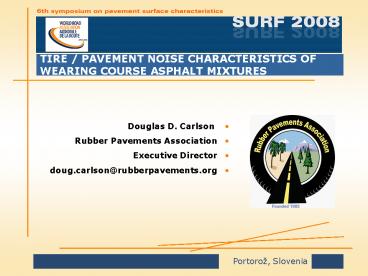TIRE / PAVEMENT NOISE CHARACTERISTICS OF WEARING COURSE ASPHALT MIXTURES - PowerPoint PPT Presentation
1 / 41
Title: TIRE / PAVEMENT NOISE CHARACTERISTICS OF WEARING COURSE ASPHALT MIXTURES
1
TIRE / PAVEMENT NOISE CHARACTERISTICS OF WEARING
COURSE ASPHALT MIXTURES
- Douglas D. Carlson
- Rubber Pavements Association
- Executive Director
- doug.carlson_at_rubberpavements.org
2
Special Thanks to Co-Authors
George B. Way - Recycled Tire Engineering
Research Foundation Ali Zareh - Arizona
DOT Kamil E. Kaloush - Arizona State
University Krishna Prapoorna Biligiri - Arizona
State University
3
PRESENTATION OUTLINE
- Research Objective
- Discussion on Asphalt-Rubber
- Interstate 10 Wearing Course Test Sections
- Background
- Pavement Types
- Pavement Mix Design
- Field Noise Studies
- Scofield, 2002
- Carlson et al, 2007
- Dynatest Inc. 2008
- Conclusions Future Research
4
OBJECTIVE
- Evaluate tire / pavement noise characteristics of
five different pavement wearing courses placed as
test sections on the Interstate-10, Arizona, by
means of field noise measurements.
5
Asphalt-Rubber (binder/bitumen)
- Components
- 80 Asphalt (Bitumen)
- 20 Ground Tire Rubber
- Common Surface in Arizona
- A-R Asphalt Concrete Friction Course
6
Scrap tires are collected for processing
7
Scrap Tires are Shredded and Granulated
8
Steel and Fiber are Removed
9
Crumb Rubber
Minus No. 10 mesh is used free of wire and other
contaminants up to 0.5 fiber.
10
Asphalt-Rubber Blending Equipment
11
Rubber is loaded into Weigh Hopper
12
By Adding Rubber to the Bitumen, The Rubber is
Able to Absorb and Retain the Aromatic Oils in
Asphalt
13
Asphalt-Rubber and Polymer Modified Bitumen
14
A-R Can Be Used Anywhere Asphalt Is Used
15
(No Transcript)
16
I-10 WEARING COURSE EXPERIMENT
- Arizona DOT Preventive Maintenance Pavement
Preservation Experiment 1999 - Mile Post 186.2 to 195.3 East Bound
- Annual Daily Traffic (ADT) 60,000 with 25
trucks - Total Equivalent Single Axle Loads (ESALs) 26
Million - 5 Asphalt Concrete Pavement Types as Test
Sections - 32 Replicate Test Cells
17
SCHEMATIC OF I-10 TEST SECTIONS
18
Picture of Dense Gradation and ARFC
19
WEARING COURSE PAVEMENT TYPES
- Asphalt Rubber Open Graded Friction Course
(AR-ACFC) - ADOT Standard Open Graded Friction Course (ACFC)
- Polymer Modified Open Graded Friction Course
(P-ACFC) - Permeable European Mixture (PEM)
- Stone Matrix Asphalt (SMA)
20
Materials and Air Voids (2008)
17.7 9.65 20.96 17.14 16.6
21
AR-ACFC ¾ (19 mm)
December 2007
22
SMA ¾ (19 mm)
December 2007
23
P-ACFC ¾ (19 mm)
December 2007
24
PEM 1 ¼ (32 mm)
December 2007
25
ACFC ¾ (19 mm)
December 2007
26
TIRE / PAVEMENT NOISE STUDIES
- OBSI NOISE MEASUREMENTS
- Scofield, 2002
- Fall 2002
- Arizonas QPP
- AR-ACFC Quietest
- Dynatest, Inc. 2008
- March 2008
- CA AZ Noise Study
- AR-ACFC Quietest
- P-ACFC Loudest
27
ADOT CPX Trailer (Scofield 2002)
28
Dynatest OBSI Configuration 2008
29
SPOT CHECK TIRE / PAVEMENT NOISE STUDY
- CARLSON ET AL, 2007
- Fall (December) 2007 ADOT ? RPA ? ASU
- OBSI technique was not used
- A hand held noise meter attached to the running
board of a van - Noise meter in close proximity to the tire /
pavement interface - A similar technique used historically in AZ
(early 1990s)
30
SPOT CHECK TIRE / PAVEMENT NOISE STUDY CONTD
AzDOT Method 1995 Spot Check 2007
31
SPOT CHECK TIRE / PAVEMENT NOISE STUDY CONTD
- Sound meter calibrated to measure sound intensity
in the range of 80 to 130 decibels (dB) - A computer connected to the sound meter to store
the data - Stored data transferred to a PC via an RS-232
interface and analyzed using the system software - 4 runs performed at three different speeds
- 60 MPH (100 Km/h)
- 72 MPH (120 Km/h)
- 75 MPH (135 Km/h)
32
TIRE / PAVEMENT NOISE COMPARISONS BETWEEN 2002,
2007 2008
33
2
5
7
11
34
35
65
35
Percent Cracking Guide
2
11
5
35
7
65
36
Raveling a Scale from 1 (best) to 5 (worst)
37
Surface Distress
38
Distress Index (Cracking and Raveling) Ranking
Section Distress
1. AR ACFC 3.2
2. SMA 10.5
3. PEM 14.2
4. ACFC 14.7
5. Polymer ACFC 19.5
39
Noise (OBSI 2008) and Distress
40
CONCLUSIONS
- OBSI Noise data for 2002 2008 and Distress
2008gtgt - 1. AR-ACFC 1. AR-ACFC 1. AR-ACFC
- 2. ACFC SMA 2. PEM 2. SMA
- 3. SMA 3. PEM
- 4. P-ACFC 4. ACFC 4. ACFC
- 5. PEM 5. P-ACFC 5. PACFC
- 2007 spot check technique agrees with 2008 OBSI
measurements, in terms of rank. Difference 1.5
dB - Noise level of each test section appeared related
to the degree of surface deterioration - AR-ACFC experienced the least cracking and wear
after 8 years of service - Future Work Field Cores collected will be used
for laboratory Noise Evaluation
41
Questions Comments































